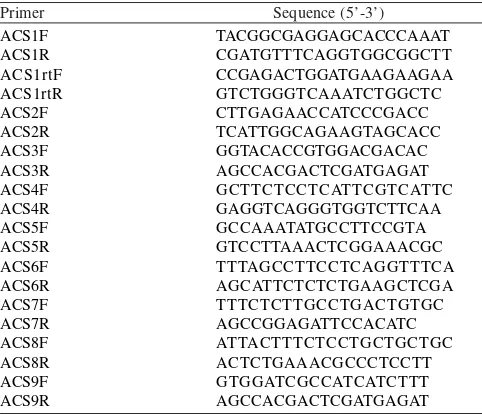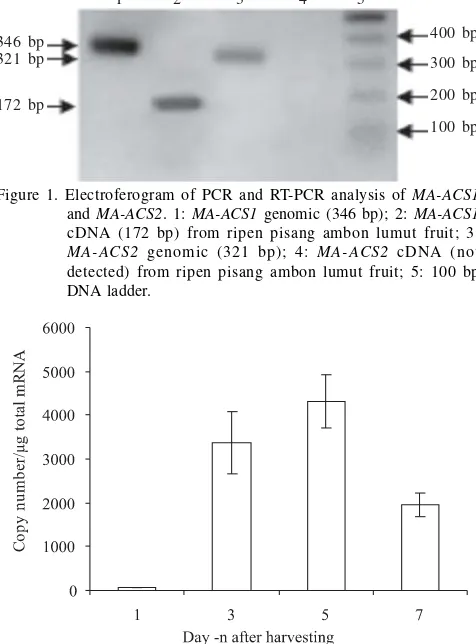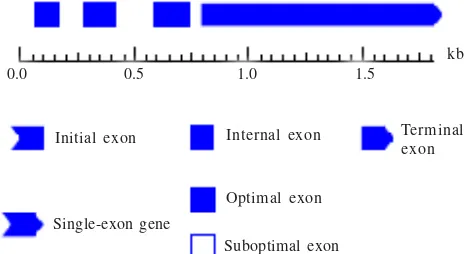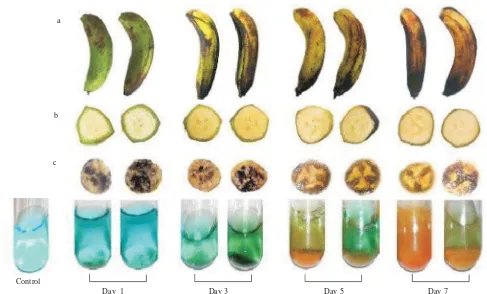ISSN: 1978-3019
Isolation of
MA
-
ACS
Gene Family and Expression Study of
MA-ACS1
Gene in
Musa
acuminata
Cultivar Pisang Ambon Lumut
LISTYA UTAMI KARMAWAN∗∗∗∗∗
, SONY SUHANDONO, FENNY MARTHA DWIVANY
School of Life Sciences and Technology, Institut Teknologi Bandung, Jalan Ganesha No. 10, Bandung 40132, Indonesia
Received January 8, 2009/Accepted March 30, 2009
Musa acuminata cultivar pisang ambon lumut is a native climacteric fruit from Indonesia. Climacteric fruit ripening process is triggered by the gaseous plant hormone ethylene. The rate limiting enzyme involved in ethylene biosynthesis is ACC synthase (ACS) which is encoded by ACS gene family. The objective of this study is to identify MA-ACS gene family in M. acuminata cultivar pisang ambon lumut and to study the MA-ACS1 gene expression. The result showed that there were nine M. acuminata ACS gene family members called MA-ACS1–9. Two of them (MA-ACS1 and MA-ACS2) were assessed using reverse transcriptase PCR (RT-PCR) for gene expression study and it was only MA-ACS1 correlated with fruit ripening. The MA-ACS1 gene fragment has been successfully isolated and characterized and it has three introns, four exons, and one stop codon. It also shows highest homology with MACS1 gene from M. acuminata cultivar Hsian Jien
Chiao (GenBank accession number AF056164). Expression analysis of MA-ACS1 using quantitative PCR (qPCR) showed
that MA-ACS1 gene expression increased significantly in the third day, reached maximum at the fifth day, and then decreased in the seventh day after harvesting. The qPCR expression analysis result correlated with the result of physical analysis during fruit ripening.
Key words: pisang ambon lumut, MA-ACS gene family, gene characterization, gene expression, quantitative PCR (qPCR) ___________________________________________________________________________
_________________ ∗
∗ ∗ ∗ ∗
Corresponding author. Phone: +62-222-51157, Fax: +62-222-514307, E-mail: fenny@sith.itb.ac.id
INTRODUCTION
Musa acuminata cultivar pisang ambon lumut is one of thousands existing banana cultivars around the world. It is well known in Indonesia and called pisang ambon lumut because it shows yellowish green peel when it has ripen (Verheij & Coronel 1992) which resembles the moss color (‘lumut’ is moss in Indonesia). Pisang ambon lumut has delicious sweet taste, specific aroma, and texture. Since banana (Musa sp.) is the world’s fourth primary food after rice, wheat, and corn (Arias et al. 2003), pisang ambon lumut would become a promising export commodity in the future. Unfortunately, banana is classified into climacteric fruit which shows ripening process in a relative short period. This phenomenon becomes a disadvantage in commercial distribution of climacteric fruits, especially if it distributed in a long distance or if an unwanted delayed transport happens. Manipulation strategy for delaying pisang ambon lumut would be advantageous for distance distribution; therefore a comprehensive data of pisang ambon lumut ripening process should be elucidated to define the manipulation technology. Previous study of pisang ambon lumut ripening process have been done by our group, such as protein isolation and characterization during banana ripening process (Insani 2006), isolation and characterization of ACS and ACO gene which involved in ethylene biosynthesis (Dwivany et al. unpublished data), and molecular strategy for controlling banana ripening using RNAi mechanism which silence specific genes involved in ethylene biosynthetic pathway (Dwivany
et al. unpublished data).
Fruit ripening process is regulated by the plant gaseous hormone, ethylene. Biochemically, fruit ripening can be defined as the summation of changes in tissue metabolism that renders the fruit attractive for consumption by organisms that assist in seed release and dispersal. In spite of fruit ripening, ethylene has the ability to switch on and off hundreds genes affecting various process. The expression or suppression of these genes induce morphological, physiological, and biochemical changes in plants in diverse events such as seed germination, abscission, fruit ripening, senescence, and various kinds of biotic and abiotic stresses (Nath et al. 2006).
Ethylene is synthesized within the cell via the ethylene biosynthetic pathway. ACC synthase (ACS) which encoded by ACS gene is the rate limiting enzyme in ethylene biosynthesis (Tsuchisaka & Theologis 2004). It catalyzed the conversion of S-adenosyl-L-methionine (SAM) into 1-aminocyclopropane-1-carboxylic acid (ACC). In the next step, ACC is converted into ethylene, CO2 and HCN by ACC oxidase (ACO) (Chaves & de Mello-Farias 2006).
In this study the gene family of ACC in pisang ambon lumut is isolated. The specific M. acuminataACS (MA-ACS) gene family member which is involved in pisang ambon lumut ripening process has been further characterized. Expression analysis using quantitative PCR (qPCR) has been performed to quantify the expression of MA-ACS1 gene during ripening process.
MATERIALS AND METHODS
Orchard 1997). This second bunch was stored in the room temperature and ripened naturally. Physical assessment and RNA isolation were conducted every two days in seven days since fruits were harvested (duplo). On the other hand, DNA isolate from banana plantlet leaf was obtained from Sadjuri (School of Life Sciences and Technology, Institut Teknologi Bandung).
RNA Isolation and First Strand cDNA Synthesis from Banana Pulp. RNA was isolated using Asif’s method (Asif et al. 2000) from banana pulp. RNA is then converted into first
strand cDNA using SuperScript™ First-Strand Synthesis
System for RT-PCR from Invitrogen®. RNA was stored in -80 oC before used for cDNA fragment isolation and expression analysis.
MA-ACS Gene Family Identification. Nine pairs of specific primers for banana MA-ACS gene family (called ACS1rt F/R
and ACS2 F/R – ACS9 F/R, Table 1) were designed based on
ACS gene family in M.acuminata cultivar Hsian Jien Chiao
(Huang et al. 2006). These primers are used for PCR analysis
to isolate ACS gene family fragmentsin M.acuminata cultivar
pisang ambon lumut. The resulting fragments which ranged between 102-346 bp were cloned into pGEM®-T Easy cloning vector, sequenced and compared with GenBank database using BLAST software (www.ncbi.nlm.nih.gov/BLAST).
Expression Analysis of MA-ACS1 and MA-ACS2. Total cDNA from unripen and ripen banana were used for qualitative expression analysis for MA-ACS1 and MA-ACS2 gene by PCR
detection method using ACS1rt F/R and ACS2 F/R primer pairs. Furthermore, qPCR (quantitative Polymerase Chain Reaction) was performed for MA-ACS1 using iQ™5 Real-Time
PCR Detection Systems with iQ™ SYBR® Green Supermix reagent. The qPCR analysis was performed for MA-ACS1 gene
expression in the fruit pulp on first, third, fifth, and seventh day after harvesting. The ACS1rt F/R were specifically designed for qPCR and then assessed by melting curve analysis. Good qPCR primers will give single peak when were assessed with melting curve analysis (Dorak 2006).
Quantification of serial MA-ACS1 gene expression was
carried out using absolute quantification method (Livak & Schmittgen 2006). Calibration curve for the absolute quantification was made using serial dilution of plasmid containing MA-ACS1 gene with known copy number for 10
times dilution, started from 300,000 until 30 plasmid copies. The resulting qPCR data for each dilution is then plotted to cycle threshold number to construct a calibration curve. The serial quantification and calibration curve reaction were done simultaneously in qPCR machine to reduce variation.
MA-ACS1 Gene Fragment Isolation and Characterization.
MA-ACS1 genomic and cDNA fragment were amplified using MA-ACS1 F/R primers (Wicaksono 2006) by PCR method from
DNA and cDNA template. The forward primer was located nearby the start codon and the reverse primer the stop codon. The resulting fragments were then cloned into pGEM®-T Easy cloning vector and sequenced. The genomic and cDNA fragment sequences were then compared and characterized using bioinformatics software, such as BioEdit, BLAST (http:/ /ncbi.nlm.nih.gov/blast), and GENSCAN 1.0 (http:// genes.mit.edu/GENSCAN.html).
Physical Assessment Method for Banana Ripening Process. Peel color, peel thickness, pulp to peel weight ratio, qualitative starch content and qualitative sugar content were analyzed for physical assessment of banana ripening process according to banana routine post-harvest screening method (Dadzie & Orchard 1997). Peel color and peel thickness was documented with digital camera. Pulp weight and peel weight were measured by digital weight balance and then plotted into a graph. Qualitative starch content within banana pulp was performed using iodine test while qualitative sugar content of pulp juice was performed using Benedict test.
RESULTS
MA-ACS Gene Family Identification. PCR of pisang ambon lumut DNA template using ACS1rt F/R and ACS2 F/R – ACS9 F/R produced nine fragments with size varying from 102 to 346 bp (Table 2). Each amplicon showed high homology with the correlated ACS gene family in M.acuminata cultivar
Hsian Jien Chiao. BLASTN identity percentage varied between 97-99% with E-value varied from 1e-41 to 7e-174 (data not shown). Expression Study of MA-ACS1 and MA-ACS2. Expression analysis of MA-ACS1 and MA-ACS2 using RT-PCR showed
that only MA-ACS1 was expressed during ripening. In other
hand, MA-ACS2 expression was not detected by
Table 1. Oligonucleotides used in gene cloning reactions and qPCR assay
electrophoresis analysis (Figure 1). Further study using qPCR absolute quantification for MA-ACS1 showed that its gene
expression increased significantly in the third day, reached maximum at the fifth day, and then decreased in the seventh day after harvesting (Figure 2). This absolute quantification was generated based on the calibration curve of MA-ACS1
which has been created before (data not shown).
Isolation and Characterization of MA-ACS1.Genomic fragment of MA-ACS1 (1818 bp, ACC number GQ396304) which
were amplified using PCR primers ACS1F and R showed highest homology (99% similarities) with MACS1 gene from M. acuminata cultivar Hsian Jien Chiao (GenBank ACC number
AF056164). The MA-ACS1 cDNA fragment (1459 bp, ACC
number GQ406064) which was amplified using PCR primers ACS1F and R (Wicaksono 2006) was also showed highest homology with the same accession number. When the genomic and cDNA fragments were aligned, it was revealed that MA-ACS1 from pisang ambon lumut has three introns, four exons,
and one stop codon (Figure 3). The fragment did not have start codon because the forward primer’s position was in the downstream of the start codon. The MA-ACS1 gene structure
was also confirmed using GENESCAN1.0 analysis and showed the same result as the alignment analysis (Figure 4). Physical Assessment Method for Banana Ripening Process. Peel color changed during pisang ambon lumut ripening started from green at the first day and gradually changed into yellowish green with black spots at the seventh
day (Figure 5a). Fruit peel became thinner and pulp to peel weight ratio increased (Figure 5b, 6), starch become degraded (Figure 5c) and sugar were accumulated (Figure 5d).
DISCUSSION
PCR result from DNA template using specific primers for the ACS gene family showed that there were at least nine ACS
genes identified in pisang ambon lumut. Sequencing and BLASTN analysis of each amplicon showed that the nine
MA-ACS genes in M.acuminata cultivar pisang ambon lumut
have a relative low E-value for homology. Identification and characterization of these MA-ACS gene family in M. acuminata cultivar pisang ambon lumut gives an opportunity
to explore the promoter of each gene family member. Spatial and temporal expression study of these promoters would be important to make it useful for other application, for example expression of antigenic protein for producing edible vaccine. Further study must be done for gene family promoter utilizations.
According to the qualitative expression analysis of MA-ACS1 and MA-ACS2 by RT-PCR showed that only MA-ACS1
was expressed during pisang ambon lumut ripening process. Subsequently, the MA-ACS1 gene became an interesting
subject for further analysis. The qPCR data showed that the expression of MA-ACS1 increased and then decreased at the
end of ripening. This data correlated with the physical assessment during its.
Physical assessment shows that chlorophyll was gradually degraded. Chlorophyll degradation is caused by the chlorophyllase activity which revealed the peel color from green into yellowish green (Chaves & de Mello-Farias 2006). Moreover, it was shown that starch within the pulp was also gradually degraded. Iodine test showed a decreasing of starch content, detected by decreased black color after stained with iodine reagent (Page 1981). Whilst, during ripening process the sugar content was gradually increased, detected by green color of Benedict reagent with yellow or red brick sediment (Page 1981). Starch degradation into sugar is catalyzed by
α-amylase activity. As the sugar is accumulated in the fruit
pulp, it is become more osmotic than the peel (Dadzie & Orchard 1997). As shown in the result, the consequence of sugar accumulation in fruit pulp was the gradual decrease in fruit peel thickness because of water evaporation and water content movements from peel to pulp.
Chlorophyllase and α-amylase activity which increased
during the pisang ambon lumut ripening is influenced by ethylene (Chaves & de Mello-Farias 2006). Therefore, it was suggested that the increased expression of MA-ACS1
correlates with ethylene production then induced the biochemical changes during fruit ripening. Decreased expression of MA-ACS1 in the late ripening maybe a result
from negative feedback regulation when ethylene accumulate in the late climacteric phase as mentioned by Inaba (2007).
Structural analysis of MA-ACS1 gene was also performed.
A longer fragment of MA-ACS1 was isolated and characterized.
The result showed that the MA-ACS1 gene structure was
similar to another MA-ACS gene family in other banana cultivar
1 2 3 4 5
Figure 1. Electroferogram of PCR and RT-PCR analysis of MA-ACS1
and MA-ACS2. 1: MA-ACS1 genomic (346 bp); 2: MA-ACS1
cDNA (172 bp) from ripen pisang ambon lumut fruit; 3:
MA-ACS2 genomic (321 bp); 4: MA-ACS2 cDNA (not
detected) from ripen pisang ambon lumut fruit; 5: 100 bp DNA ladder.
0.0 0.5 1.0 1.5
kb
Initial exon
Single-exon gene
Internal exon
Optimal exon
Suboptimal exon
Terminal exon
Figure 4. Structure prediction of putative MA-ACS1 gene fragment using GENSCAN1.0MA-ACS1 had four exons, three intron, and one stop codon.
and ACS gene family in another plant taxa such as
Arabidopsis (van der Straeten et al. 1992) and tomato (Olson
et al. 1991). It showed that the MA-ACS1 is conserved among plant species and may have a similar function.
There are still a lot of unexplored properties of pisang ambon lumut ripening process and comprehensive studies should be carried out to reveal them. In the future, biotechnology would help us to discover, to use, and to improve the biological potential of pisang ambon lumut for human welfare.
ACKNOWLEDGEMENT
This study is sponsored by PT. Indofood Sukses Makmur – Indofood Riset Nugraha 2006.We thank PT. Indofood Sukses Makmur for the research grant from “Indofood Riset Nugraha 2006”. We also thank to Sadjuri for pisang ambon lumut DNA sample.
a
b
c
d
Control P1a P1b P3a P3b P5a P5b P7a P7b
Day 1 Day 3 Day 5 Day 7
Figure 5. Qualitative physical assessment during pisang ambon lumut ripening. Two samples were assessed every two days from day 1 until day 7 since harvested. a. Peel colour changes; b. transversal section of banana fruit, showed gradual decrease in peel thickness; c. Iodin test for starch detection, black stain showed detected starch; d. Benedict test for sugar detection.
Figure 6. Average ratio of banana pulp to peel weight during pisang ambon lumut ripening.
REFERENCES
Arias P, Dankers C, Liu P, Pilkauskas P. 2003. The World Banana
Economy, 1985-2002: FAO Commodity Studies. Rome: FAO.
Asif MA, Dhawan P, Nath P. 2000. A Simple Procedure for the Isolation of High Quality RNA from Ripening Banana Fruit. Plant Mol Biol Rep 18:109-115.
Chaves ALS, de Mello-Farias PC. 2006. Ethylene and fruit ripening: from illumination gas to the control of gene expression, more than a century of discoveries. Genet Mol Biol 29:508-515. Dadzie BK, Orchard JE. 1997. Routine Post-Harvest Screening of
Banana/Plantain Hybrids: Criteria and Methods. France: INIBAP. Dorak MT. 2006. Real-time PCR. New York: Taylor & Francis Group.
Huang FC, Do YY, Huang PL. 2006. Genomic organization of a diverse ACC synthase gene family in banana and expression characteristics of the gene member involved in ripening of banana fruits. J Agric
Food Chem 54:3859-3868.
Inaba A. 2007. Studies on the internal feedback regulation of ethylene biosynthesis and signal transduction during fruit ripening, and the improvement of fruit quality. J Japan Soc Hort Sci 76:1-12. Insani M. 2006. Isolasi dan Analisis SDS–Page Total Protein dari
Pematangan Buah Pisang Ambon Lumut (Musa sp.) [Thesis]. Bandung: Institut Teknologi Bandung.
Livak KJ, Schmittgen TD. 2001. Analysis of relative gene expression data using real-time quantitative PCR and the 2-ÄÄCT method.
Methods 25:402-408.
Nath P, Trivedi PK, Sane VA, Sane AP. 2006. Role of ethylene in fruit ripening. In: Khan NA(ed). Ethylene Action in Plants. Heildelberg: Springer-Verlag Berlin Heidelberg.
Olson CD, White JA, Edelman L, Harkins RN, Kende H. 1991. Differential expression of two genes for 1-aminocyclopropane-1-carboxylate synthase in tomato fruits. Proc Natl Acad Sci
88:5340-5344.
Page DS. 1981. Principles of Biological Chemistry. 2nd ed. Jakarta:
Erlangga.
Tsuchisaka A, Theologis A. 2004. Unique and overlapping expression patterns among the arabidopsis 1-Amino-cyclopropane-1-carboxylate synthase gene family members. Plant Physiol
136:2982-3000.
van der Straeten D et al. 1992. Cloning genetic mapping, and expression analysis of an Arabidopsis thaliana gene that encodes 1-aminocyclopropane-1-carboxylate synthase. Proc Natl Acad Sci 89:9969-9973.
Verheij EWM, Coronel RE. 1992. Plant Resource of South East Asia:
Edible Fruits and Nuts. Volume 2. Bogor: PROSEA Foundation. Wicaksono BD. 2006. Isolasi, Kloning, dan Analisis Ekspresi Gen



